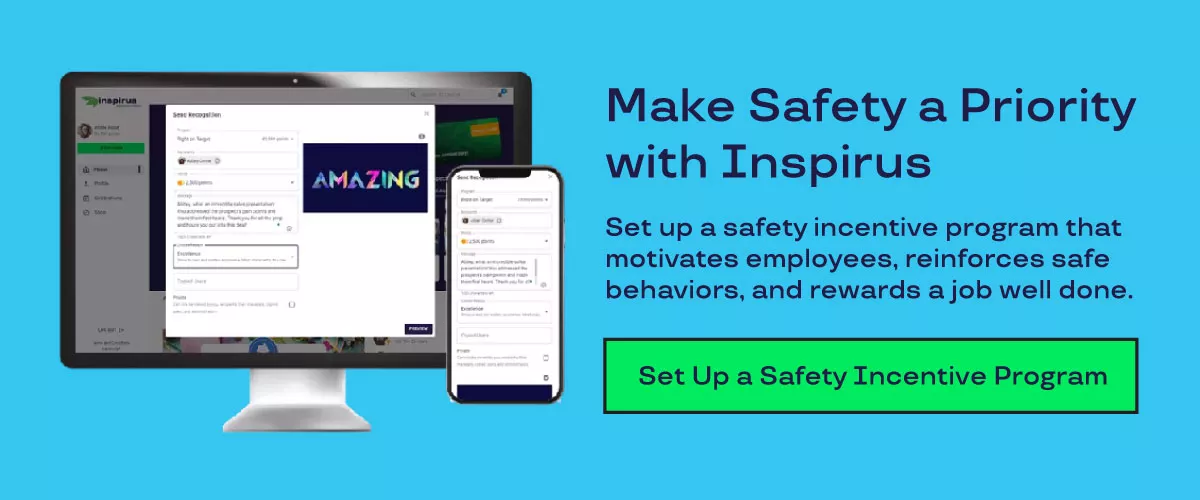How to Implement Safety Incentive Programs Using Employee Recognition and Rewards

Create a safer, more engaged workplace with a well-designed safety incentive program. Discover how with employee recognition and rewards.
Will using employee rewards and recognition reinforce workplace safety? Having a workplace safety program is essential for any business, company, or corporation. A safe work environment is good for everyone — it protects employees, employers, and visitors, plus it maintains the daily workflow.
However, safety is often disregarded over time. If a person performs the same task(s) every day, it’s natural for them to grow comfortable and feel secure. If one of your workers has performed a certain task or job the same way hundreds of times without being injured or causing an accident, they may think nothing could possibly go wrong. Unfortunately, if a job is done improperly or unsafely, it can — and typically does — go wrong. The worst results are injuries, damage to the workplace or work equipment and worst of all, death.
To create a safer working environment, your business should consider implementing a culture of safety.
What is a Safety Rewards and Recognition Program?
Safety rewards and recognition is a workplace safety program designed to use motivational methods of rewarding employees that encourage safe behavior and discourage unsafe behavior and safety infractions. The goal of this kind of program is to minimize preventable accidents and create a safer, more positive work environment.
A safety rewards and recognition program achieves this goal by rewarding the safe behaviors and actions of each employee, while penalizing unsafe behaviors and actions. A successfully implemented safety recognition program can change a company’s culture, making it a place where safety and safe behavior is promoted not only by safety managers, but by the employees themselves.
The Features of Safety Incentive Programs
For a safety rewards and recognition program — also known as a safety incentive program — to work effectively, the program should be:
OSHA-Compliant
The U.S. Occupational Health and Safety Administration (OSHA) was created to ensure safety in workplaces (ergo, for workers) across the United States. In doing so, OSHA enforces a number of rules and regulations. Any program with safety incentives must abide by OSHA regulations. For example, employees who are part of a safety rewards and recognition program should not fear the loss of incentives when workplace injuries occur. This would be a violation of OSHA regulations.
Fun
A safety incentives program should inspire a positive attitude change toward safety for employees and other members of staff. Making the program fun will foster a constructive atmosphere and inspire employees to have a positive attitude about safety and safe behavior.
Understandable
To work properly, a program with safety incentives must be understandable. It should be clear, concise and easy for employees to grasp quickly. This is not the kind of situation where you want people to learn as they go — everything should be laid out and understood before implementation.
Rewarding
The incentives to an employee for reporting safety and safe behavior must be rewarding. Obviously, employees should be motivated to achieve the incentives. One of the best ways to ensure your incentives are desirable is to simply ask your employees what they want for reporting incidents and what will motivate them.
By using a digital employee recognition platform like Inspirus Connects, you can streamline program management while giving employees the power to choose their rewards. This ensures they receive something meaningful and relevant to them, making the recognition experience more impactful. When employees feel valued with rewards that match their preferences, they’re more likely to stay engaged in workplace safety efforts — strengthening your safety culture in the process.
Want to know which rewards truly motivate employees? Discover what makes recognition meaningful and the top 90 employee rewards by budget level.
Hard to Resist
Peer pressure is often frowned upon for a number of reasons. However, when used in a healthy way, peer pressure can be a great benefit for workplace safety programs. This benefit can be achieved through group incentives.
Group incentives are just as they sound: incentives for groups. If an entire group does well, there is a reward for all of them — as opposed to just one reward for one compliant employee. Creating an all-in-this-together atmosphere can go a long way in changing workplace team culture and a staff’s general attitude toward safety.
Conducive to Behavioral Change
Again, the goal of safety incentives in a safety rewards and recognition program is to encourage a change in behavior. The program aims to develop safer employee behavior through positive reinforcement. Safety incentives must be used to encourage that development. Using positive reinforcement to increase the safety of employee actions and behaviors will in turn create positive behavioral change.
Easy to Administer
Without proper execution, any great idea, plan or program will fail. Whatever program your company chooses, it must be committed to and administered properly. Program administration will be a daily task, so make the program easy to manage! Without daily administration, the program will not be as effective in creating the safe environment you and your employees need.
Flexible and Dynamic
Lastly, a workplace safety program has to be flexible and dynamic. It’s easy for people to be enthusiastic about new ideas and programs. However, once they get used to something, humans grow bored and lose their enthusiasm. To keep morale high and employees engaged, a safety rewards and recognition program must be flexible and changeable.

Reward and Recognize Employees for Desired Behavior
Here are a few behaviors you can reward and recognize employees for:
Warehouse Workers:
- General safety practices
- Safe forklift operation and maintenance
- Correct materials handling
- Organization and cleanliness
- Proper wear and cleaning of personal protective equipment (PPE)
- Participation in OSHA training
- Preventative ideas and solutions
Drivers:
- Achieving milestone goals
- Modifying driving behavior
- Improving their safety scorecard
- Dedication to safety results
- Policy adherence to avoid tickets
- Mentoring newer drivers
- Completion of training
Examples of Effective Rewards for a Safety Incentive Program
The right rewards can make all the difference in motivating employees to prioritize workplace safety. A well-designed safety incentive program should offer meaningful, desirable rewards that reinforce positive behaviors.
Here are some effective reward options to consider:
- Monetary Bonuses: Direct financial incentives, such as cash rewards or added bonuses, can be powerful motivators for employees to follow safety protocols and report incidents.
- A Gift of Choice Through a Digital Recognition Platform: Platforms like Inspirus Connects allow employees to choose rewards that fit their needs (and your budget!), making recognition more meaningful and personalized.
- Award Certificates and Plaques: Recognizing employees with certificates, plaques or trophies can provide public acknowledgment of their commitment to workplace safety.
- Extra Time Off: Offering additional paid time off (PTO) as a reward can serve as a strong motivator while also promoting work-life balance.
- Company-Branded Swag and Safety Gear: Items like custom apparel, safety gear or branded merchandise serve as both rewards and reminders of the company’s commitment to safety.
No matter which rewards you choose, the key is to ensure they are meaningful, valued and easily accessible to employees. Combining different types of rewards can help maintain engagement and make your safety incentive program even more effective.
Why Your Business Needs a Safety Rewards and Recognition Program
An effective workplace safety program is beneficial for many reasons. The first is that it’s cost-effective. According to the Occupational Safety and Health Administration (OSHA), workplace injuries and illnesses have a major impact on an employer's bottom line. It’s estimated that employers pay almost $1 billion per week for direct workers' compensation costs alone. Combine that with indirect costs such as lost time, and total costs can add up quickly.
Investing in a safety incentive program can remove or reduce high costs like these. Even with the cost of lost production time and the (potential) additional cost of training time, investing in safety recognition programs still saves employers money.
Safety incentive programs that offer rewards change the culture of a work environment for the better. They create a more pleasant workplace where employee satisfaction flourishes and loyalty deepens. The positive culture these programs create retains employees and boosts their productivity, which often leads to an increase in profitability as well.
Set Up a Safety Incentive Program with Inspirus
A great safety incentive program does more than reward safe behavior — it builds a culture where safety comes first. Inspirus can help you create a tailored program that engages employees, reinforces safety goals and makes recognition simple.
Let’s make workplace safety a priority. Talk to us today to get started!






